+ALL
THINGS GOTHIC ON BUFFY THE VAMPIRE SLAYER+
Season
7 references up to 7.9 'Never Leave Me' - you have been warned!
What is
the Gothic? The literary gothic was a genre in the 18th and
19th centuries in Britain, which developed as a reaction against
the Age of Reason and what we might think of as the rise of
science and rationalism, with famous 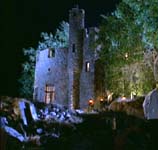 authors
including Bram Stoker, Mary Shelley, Anne Radcliffe and Matthew
Lewis, and Edgar Allen Poe in America. It was about anxiety,
the supernatural, morality and the limits of existence; often
it was about extremes and the extraordinary. Today it usually
refers to people who wear fishnet stockings and say they prefer
night to day, but while the term isn't often used to describe
modern fiction, everything that makes up the Gothic is alive
in well in literature, film and TV; not just in the work of
Anne Rice, but everywhere. Replace the term with 'horror', and
you get better idea of the Gothic's pervading influence. authors
including Bram Stoker, Mary Shelley, Anne Radcliffe and Matthew
Lewis, and Edgar Allen Poe in America. It was about anxiety,
the supernatural, morality and the limits of existence; often
it was about extremes and the extraordinary. Today it usually
refers to people who wear fishnet stockings and say they prefer
night to day, but while the term isn't often used to describe
modern fiction, everything that makes up the Gothic is alive
in well in literature, film and TV; not just in the work of
Anne Rice, but everywhere. Replace the term with 'horror', and
you get better idea of the Gothic's pervading influence.
HORROR
VS. TERROR
If we think
of horror, we think of movies which aren't necessarily scary,
but which are often capable of shocking the audience. Horror
means lots of blood, lots of monsters and probably some running
around while being chased by things. But 'terror' is an equally
important part of the Gothic, arguably more so. Horror is about
being graphic, about being disgusting or horrific, its power
in presenting visceral images or death and murder and an unambiguous
supernatural. Terror, on the other hand, is more subtle; it
isn't interested in showing so much, but rather in building
up fear and apprehension; terror is mental, whereas horror is
more physical. The majority of the most powerful Horror-genre
films are actually about terror, not horror; The Exorcist,
for example, and The Omen both use terror to build
up, before some scenes of horror. Horror is what B-movies and
cheap fiction thrives on; gore and guts, and probably some sex,
too. Terror can make you afraid, whereas horror can shock you.
Neither
mode is the more gothic; most gothic novels use a mixture of
the two, to some extent. Buffy uses horror as its basic mode,
because it's based on the tradition of Horror films; which means
that vampires and monsters are usually up front and fairly horrific,
and that the supernatural is fairly unambiguous. However the
show has also uses terror frequently, often in deliberate contrast
to the less deep horror elements.
In Season
2, Angel's mental torture of Buffy was an exercise in terror,
using psychological means and based around small but subtle
tactics such as the bundle of black-ribboned roses. Terror doesn't
usually make the object of the terror clear, or even make its
existence concrete; it's all about the imagination of both the
character and the readers. In the episode 'Amends', Angel's
mind is manipulated by an obscure force (the First) which uses
subtle means to achieve a state of confusion and fear; in Season
7, the same tactics are used again. While terror typically exists
primarily in the mind of the characters, the nature of Buffy
means that the First is more explicit and visible.
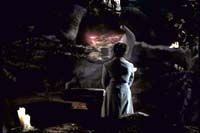 In
'Amends', Buffy herself is confronted by the First. Having abandoned
terror, it reverts to horror, trying to shock Buffy by making
itself visually frightening. Buffy isn't impressed; her reaction
demonstrates the specific way the Gothic works in the show.
Instead of terror being built up, it is frequently undercut
by humour, and horror isn't often expected to be shocking. The
novel 'Dracula' was an exercise in terror, but the same terror
can't be brought to Buffy the Vampire Slayer, because this is
the Age of Reason; the Gothic has relied on superstition, and
on the believability of its fantastic situations. But in a postmodern
world it's less easy to be terrified by something, certainly
not a TV show with advert breaks every ten minutes. Similarly
horror is less horrific, because audiences no longer accept
that shocking images are 'real'. Buffy plays with this idea,
introducing monsters that are not horrific, by subverting them
or by acknowledging that they're fictional archetypes. The episode
'Buffy vs. Dracula' revisited the most famous Gothic novel,
but while Dracula was portrayed with some seriousness, ultimately
he was undercut by humour and by the acknowledgement that he
was a fictional character. In
'Amends', Buffy herself is confronted by the First. Having abandoned
terror, it reverts to horror, trying to shock Buffy by making
itself visually frightening. Buffy isn't impressed; her reaction
demonstrates the specific way the Gothic works in the show.
Instead of terror being built up, it is frequently undercut
by humour, and horror isn't often expected to be shocking. The
novel 'Dracula' was an exercise in terror, but the same terror
can't be brought to Buffy the Vampire Slayer, because this is
the Age of Reason; the Gothic has relied on superstition, and
on the believability of its fantastic situations. But in a postmodern
world it's less easy to be terrified by something, certainly
not a TV show with advert breaks every ten minutes. Similarly
horror is less horrific, because audiences no longer accept
that shocking images are 'real'. Buffy plays with this idea,
introducing monsters that are not horrific, by subverting them
or by acknowledging that they're fictional archetypes. The episode
'Buffy vs. Dracula' revisited the most famous Gothic novel,
but while Dracula was portrayed with some seriousness, ultimately
he was undercut by humour and by the acknowledgement that he
was a fictional character.
THE
UNHEIMLICH
While we are no longer frightened by many of the things that
the Gothic has often relied upon, the unhiemlich or uncanny
still holds as much power as it is has always done. Cliched
devices for building up terror, such as the use of atmospheric
music or lonely dark corridors, have been subverted by the show
as much as devices for horror have. But all things unhiemlich
are used when the show really wants to step into the
Gothic and become more deeply involved in it. Freud's
idea of the unhiemlich centred around not unfamiliar or alien
things such as werewolves and demons, but around the familiar,
and around things which are both difficult to define, and difficult
to escape from. Something which is familiar, but also frightening.
'Creepy' is often a good adjective to describe things which
are unhiemlich.
'Hush' is
an episode which uses the power of the unhiemlich to create
terror. While using some of the typical Gothic cinema effects
(background music, dark lighting and shadows, unwanted silence),
it relies on the making of the familiar seem terrifying. The
Gentlemen themselves are not conventional horrific monsters,
but more humanlike; they look like us, but they aren't us. They
mimic human politeness, and the precision of surgeons. They
wear clothes, but don't walk. 'Hush' uses the unexplained, and
its effect on the everyday; Buffy and Willow wake up on a normal
morning, but can't speak. Everything is at once familiar but
also disturbing or foreign.
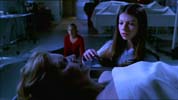 While
'Hush' existed within a relatively recognisable Horror genre
style, 'The Body' was an episode which used terror in a less
obvious way. Things which are unhiemlich are often things which
seems to be neither one thing or another, neither animated nor
inanimate, dead or alive. A familiar character since the start
of the show, on her death Joyce's body becomes unhiemlich to
Buffy; is the body her mother, or just a dead thing? The moment
at which she comes to the realisation that her mother is 'the
body' is the moment at which the terror is resolved; rationalising
terror often leads to its resolution, as if by understanding
something negates its power. For Dawn, the moment of unhiemlich
and terror comes when she reaches out to her mother's body;
lying there in the mortuary, Joyce doesn't seem to be real,
or to be dead or alive. Death is a very unhiemlich event, because
while it's inevitable and familiar to everyone, it's also unexplained,
uncanny, disturbing. 'The Body' deals with the relationship
to the body of someone who has died, and the fear and dread
its uncertain and undetermined nature brings. While
'Hush' existed within a relatively recognisable Horror genre
style, 'The Body' was an episode which used terror in a less
obvious way. Things which are unhiemlich are often things which
seems to be neither one thing or another, neither animated nor
inanimate, dead or alive. A familiar character since the start
of the show, on her death Joyce's body becomes unhiemlich to
Buffy; is the body her mother, or just a dead thing? The moment
at which she comes to the realisation that her mother is 'the
body' is the moment at which the terror is resolved; rationalising
terror often leads to its resolution, as if by understanding
something negates its power. For Dawn, the moment of unhiemlich
and terror comes when she reaches out to her mother's body;
lying there in the mortuary, Joyce doesn't seem to be real,
or to be dead or alive. Death is a very unhiemlich event, because
while it's inevitable and familiar to everyone, it's also unexplained,
uncanny, disturbing. 'The Body' deals with the relationship
to the body of someone who has died, and the fear and dread
its uncertain and undetermined nature brings.
DOPPELGOTHLAND
Another aspect of Freud's uncanny which has particular reference
to Buffy is the doppelganger, and this can mean a 'split personality'
as well as the double self. The Gothic uses the doppelganger
to illustrate anxieties or aspects of a character's personality,
or about the human condition. There have been many obvious doppelgangers
in Buffy; in 'Dopplegangland' Willow's doppelganger made physical
many of her desires and her so-called 'dark side'. Xander's
split doppelganger in 'The Replacement' portrayed the good and
bad points of his character, both charming and lacking in 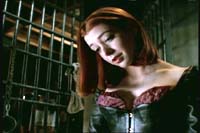 confidence.
Angel/Angelus was about both Angel's inner darkness, but more
pointedly about the inner darkness and cruelty of men (a feminist
statement), and also generally about the duality of all humans;
Oz/Werewolf made the same points, as did the other selves in
'Beauty and the Beasts' and Xander's hyena possession in 'The
Pack'. Spike's duality in 'Sleeper' represented not only his
own fears about returning to evil, but the fear that he would
be uncontrollable, unable to control 'the beast'; much as 'Wild
at Heart' represented the same fear for Oz. confidence.
Angel/Angelus was about both Angel's inner darkness, but more
pointedly about the inner darkness and cruelty of men (a feminist
statement), and also generally about the duality of all humans;
Oz/Werewolf made the same points, as did the other selves in
'Beauty and the Beasts' and Xander's hyena possession in 'The
Pack'. Spike's duality in 'Sleeper' represented not only his
own fears about returning to evil, but the fear that he would
be uncontrollable, unable to control 'the beast'; much as 'Wild
at Heart' represented the same fear for Oz.
However
many less explicit Gothic doppelgangers have been shown. The
First Slayer in Buffy's dream in 'Restless' made visible her
fears about being a 'killer', of being someone with power but
not control, and of losing herself in her slaying. Many other
characters exist in part as doubles of others; Dawn is Buffy's
double, initially illustrating her negative points, namely becoming
absorbed in herself and in her Otherness or supernatural nature
and seeing herself as set apart from others. Tara initially
represented an earlier, less confident Willow, with Willow's
bringing of Tara out of herself as symbolic of Willow's own
growth. In Season 6 the Troika are the double of the Scooby
Gang; what they could become if they ceased to take the fantastic
elements of their life as seriously, and treated them as fiction
rather than 'reality', which each Scooby representing elements
of Buffy, Willow and Xander. Warren illustrates Buffy's fears
of becoming a cold, emotionless killer incapable of love and
using others rather than understanding them. Jonathan is Willow's
double, lacking in confidence and led by others rather than
being in control of his own power. Andrew represents Xander's
fears of being insignificant, the third wheel.
SO'CAL
DREAMING
The dream state, and the idea of the prophetic or psychologically
significant dream is a key Gothic feature. Dreams, like doppelgangers
or other manifestations, demonstrate the inner mind of the characters,
as well as having supernatural elements. The four dreams in
'Restless' were both psychological, and prophetic; they illustrated
the character's fears (Willow's fear of being 'found out' as
less confident then she really was; Xander's of being trapped
in his basement and staying the least intelligent or useful
Scooby, Giles' fear of not being able to help or understand
Buffy, and Buffy's fear at becoming a killer with bad hair),
and the dreams also foreshadow events to come in both a literal
and emotional way, in terms of actual plotlines and character's
individual feelings.
HOUSE
 The
House, mansion or castle is always a powerful Gothic metaphor.
Typically the house represents the emotions of the people who
live in it, which is why terrifying castles and run-down mansions
are so popular, as they aptly represent the turbulent emotions
of Gothic characters. There are two main buildings in Buffy;
Sunnydale High, and the Summers' house. The Summers' house often
literally represents the turmoil of the characters, particularly
in 'Conversations with Dead People' where it represents that
disorder of Dawn's mind, and the confusion of the events. However
the different levels of the house also have significance; lighting
is a key feature of Gothic cinema, and in the bedrooms it can
be either airy or dark, mirroring the events being acted out.
The basement is always significant in the Summers' house. In
'Normal Again', its dark, cluttered nature symbolises Buffy's
own confusion and anxiety; in 'Never Leave Me', the underground
surroundings of Buffy and Spike's conversation suggest that
something is buried or hidden. The
House, mansion or castle is always a powerful Gothic metaphor.
Typically the house represents the emotions of the people who
live in it, which is why terrifying castles and run-down mansions
are so popular, as they aptly represent the turbulent emotions
of Gothic characters. There are two main buildings in Buffy;
Sunnydale High, and the Summers' house. The Summers' house often
literally represents the turmoil of the characters, particularly
in 'Conversations with Dead People' where it represents that
disorder of Dawn's mind, and the confusion of the events. However
the different levels of the house also have significance; lighting
is a key feature of Gothic cinema, and in the bedrooms it can
be either airy or dark, mirroring the events being acted out.
The basement is always significant in the Summers' house. In
'Normal Again', its dark, cluttered nature symbolises Buffy's
own confusion and anxiety; in 'Never Leave Me', the underground
surroundings of Buffy and Spike's conversation suggest that
something is buried or hidden.
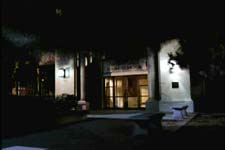 Sunnydale
High is a more complex Gothic building than the archetypical
castle. In past seasons, it wasn't lived in, and presented a
bland and acceptably non-Gothic facade; the turmoil was within,
and Buffy's role, in episodes such as 'Passion' or 'The Zeppo',
was to keep the Gothic manifestations of mental turmoil from
escaping. School was hell, but didn't appear so. As a modern
Gothic metaphor, the school is more subtle than the classic
'honkin' big castle', though clearly the giant snakes and many-headed
beasties that appear in and around the school are less so. In
Season 7 the new school has changed, by dint of being inhabited.
Spike's mental turmoil was represented by the corporeal spirits
in 'Lessons', and the earth-floored maze-like basement is more
explicitly representative of the unrest, amongst the people
who go to school in the building, than the fairly innocuous
Sunnydale High Mark I was. Sunnydale
High is a more complex Gothic building than the archetypical
castle. In past seasons, it wasn't lived in, and presented a
bland and acceptably non-Gothic facade; the turmoil was within,
and Buffy's role, in episodes such as 'Passion' or 'The Zeppo',
was to keep the Gothic manifestations of mental turmoil from
escaping. School was hell, but didn't appear so. As a modern
Gothic metaphor, the school is more subtle than the classic
'honkin' big castle', though clearly the giant snakes and many-headed
beasties that appear in and around the school are less so. In
Season 7 the new school has changed, by dint of being inhabited.
Spike's mental turmoil was represented by the corporeal spirits
in 'Lessons', and the earth-floored maze-like basement is more
explicitly representative of the unrest, amongst the people
who go to school in the building, than the fairly innocuous
Sunnydale High Mark I was.
GOING
TO EXTREMES
Extremity, the limits of human morality and existence, is perhaps
the most significant Gothic feature, and what created the genre
in the first place; it was a reaction against reason and moderation.
The Gothic is about another, less polite or  'realistic'
world, in which the unreal is both real and dangerous,
and in which the characters don't behave in a 'normal' way,
or aren't able to. The Buffyverse is in this way a very Gothic
universe, in that it frequently seeks to test the limits of
being human. Vampires, as well as being unhiemlich and other-but-familiar,
are also extreme humans; horrific, in their lack of morality
and their violence, but also capable of understanding both human
emotions and human morals. Buffy herself lives her life in an
extreme way, living with terror and horror; the other Scoobies'
arcs have often explored the depths and heights of humanity.
The Gothic seeks to exaggerate and to dramatise the internal
in an external way; in the Season 6 finale, Willow's inner struggle
is taken to a literal level with the whole world becoming an
extended house-type metaphor for both her angst, and more generally
that of humanity as a whole. The Gothic always pushes the envelope
as far as intensity of emotion is concerned, and in the destructive
and powerful events that dramatise the emotions of the characters. 'realistic'
world, in which the unreal is both real and dangerous,
and in which the characters don't behave in a 'normal' way,
or aren't able to. The Buffyverse is in this way a very Gothic
universe, in that it frequently seeks to test the limits of
being human. Vampires, as well as being unhiemlich and other-but-familiar,
are also extreme humans; horrific, in their lack of morality
and their violence, but also capable of understanding both human
emotions and human morals. Buffy herself lives her life in an
extreme way, living with terror and horror; the other Scoobies'
arcs have often explored the depths and heights of humanity.
The Gothic seeks to exaggerate and to dramatise the internal
in an external way; in the Season 6 finale, Willow's inner struggle
is taken to a literal level with the whole world becoming an
extended house-type metaphor for both her angst, and more generally
that of humanity as a whole. The Gothic always pushes the envelope
as far as intensity of emotion is concerned, and in the destructive
and powerful events that dramatise the emotions of the characters.
Limits of
love, linked to pain and pleasure, are explored in the show
through sadism and masochism, often a Gothic preoccupation.
The relationship between Spike and Drusilla exists on this edge,
as does his relationship with Buffy. Both explore the limits
of love in relation to morality. Love is a powerful, destructive
force as much as it is healing; in a Gothic world, love is frequently
close to hate, jealousy and revenge. Damnation and redemption
are Gothic themes, with the first often being the most common;
Gothic characters often subscribe to the Calvinist idea that
every human being is effectively damned from birth, and in the
Buffyverse certainly vampires can be seen as the damned, in
a way which demons in general are not. Love as a positive force
is not typically a Gothic feature, but rather the type of mutual
abuse that characterised Buffy and Spike's relationship in Season
6 typifies a Gothic romance.
THE
POSTMODERN GOTHIC
Many other aspects associated with the Gothic are represented
in Buffy (the villain hero, pursued heroine), and are also often
subverted. Buffy's relationship with the Gothic is always set
alongside its relationship with postmodernism, or simply with
it being modern; the Gothic insists that terror and
horror must be given power and credence by the narrative, and
that we must be effected by these things, whereas postmodernism
points out that these things are not real, but are part of generic
modes which the audience understands. Buffy exists within the
Gothic, but often steps outside it to view the idea of terror,
horror and other Gothic features more objectively, or ironically.
Doppelgangers are as much a feature for comedy as they are for
terror and portent, for example. But while some features of
the Gothic (those most associated with the Horror film genre)
are sometimes pastiched by the show, in fact Buffy remains true
to the Gothic principle of a narrative where the supernatural
is a metaphor for the psychology of the characters, and where
a darker, hidden side of life, and the limits of morality are
explored.
+LINKS+
The
Gothic Literature Page
The
Uncanny and the Fantastic
A
Glossary of Literary Gothic Terms
|
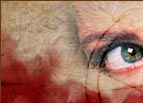
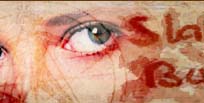
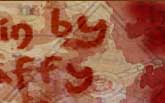






 'realistic'
world, in which the unreal is both real and dangerous,
and in which the characters don't behave in a 'normal' way,
or aren't able to. The Buffyverse is in this way a very Gothic
universe, in that it frequently seeks to test the limits of
being human. Vampires, as well as being unhiemlich and other-but-familiar,
are also extreme humans; horrific, in their lack of morality
and their violence, but also capable of understanding both human
emotions and human morals. Buffy herself lives her life in an
extreme way, living with terror and horror; the other Scoobies'
arcs have often explored the depths and heights of humanity.
The Gothic seeks to exaggerate and to dramatise the internal
in an external way; in the Season 6 finale, Willow's inner struggle
is taken to a literal level with the whole world becoming an
extended house-type metaphor for both her angst, and more generally
that of humanity as a whole. The Gothic always pushes the envelope
as far as intensity of emotion is concerned, and in the destructive
and powerful events that dramatise the emotions of the characters.
'realistic'
world, in which the unreal is both real and dangerous,
and in which the characters don't behave in a 'normal' way,
or aren't able to. The Buffyverse is in this way a very Gothic
universe, in that it frequently seeks to test the limits of
being human. Vampires, as well as being unhiemlich and other-but-familiar,
are also extreme humans; horrific, in their lack of morality
and their violence, but also capable of understanding both human
emotions and human morals. Buffy herself lives her life in an
extreme way, living with terror and horror; the other Scoobies'
arcs have often explored the depths and heights of humanity.
The Gothic seeks to exaggerate and to dramatise the internal
in an external way; in the Season 6 finale, Willow's inner struggle
is taken to a literal level with the whole world becoming an
extended house-type metaphor for both her angst, and more generally
that of humanity as a whole. The Gothic always pushes the envelope
as far as intensity of emotion is concerned, and in the destructive
and powerful events that dramatise the emotions of the characters.